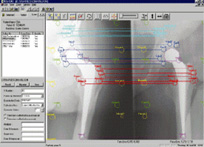 Clinical studies have shown that early motion (migration) of un-cemented implants is related to later loss of the implant. Clinical studies have shown that early motion (migration) of un-cemented implants is related to later loss of the implant.
Prosthesis magration can be examined by the use of marker-based radio stereometric analysis (RSA).
In order to carry out this examination the joint prostheses are marked with tantalum balls which can be recognized by the computer software RSA-CMS (Medis Specials, Holland). Furthermore, tantalum balls are placed in the bone near the prosthesis.
By means of a stereometric picture, taken immediately after the oparation, the prosthesis' initial position in relation to fixation points in the bone is determined by means of a test grid.
Control stereometric pictures are taken according to determined time intervals. By comparing the pictures the prosthesis' displacement from the bone fixation points can be determined in three dimensions as a function of time. If the prosthesis migrates from the surrounding bone a mechanical solution may be contemplated.
Today researchers and clinicians agree that the effect of new surgical methods at the insertion and design of a prosthesis should be evaluated through migration studies before they can be recommended for general use.
By means of RSA it is possible to gain a very precise evaluation of the prosthesis migration, i.e. down to 0.11 mm. |